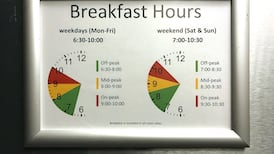Inside Politics/Stephen Collins: Bertie Ahern was having his usual late evening pint of Bass with his pals in Fagan's of Drumcondra last Tuesday when into his lair strode none other than Enda Kenny, his rival for Taoiseach in the next election.
Jaws dropped at the unexpected incursion of the Fine Gael leader from Mayo on to the Taoiseach's home ground in Dublin and locals wondered what the world was coming to.
The party leaders had a friendly chat as Mr Kenny explained that he was in the mood for a relaxing pint himself, having just finished one of his round of public meetings at the Regency Hotel down the road.
He told the Taoiseach he wouldn't try and cramp his style by staying in Fagan's and the Fine Gael group headed off to another pub down the road. While the encounter was good humoured, both leaders being civilised men who get along reasonably well despite their political rivalry, the hard-nosed political types in Fagan's concluded that Mr Kenny was making a point. He is coming after the Fianna Fáil leader and there is no longer any safe hiding place, not even the Taoiseach's favourite pub.
By this time next year we will know which of them has come out on top; whether Mr Ahern is able to pull off an astonishing three-in-a-row election victories or whether Mr Kenny has the ability to put a halt to his gallop. Mr Ahern has seen off two Fine Gael leaders, John Bruton and Michael Noonan, and it would be a remarkable achievement if he can see off a third.
The task facing Mr Kenny is of an even higher order, in the light of the drubbing Fine Gael took in 2002. That he has brought Fine Gael back into contention at all is some achievement. Nobody four years ago would have predicted that he had a chance of achieving a goal that eluded not just Mr Noonan and Mr Bruton but Alan Dukes before them - beating Fianna Fáil in a general election.
By next summer, Mr Ahern's Fianna Fáil-PD coalition will have been in office for 10 years on the trot. Looked at in an even wider timeframe, Fianna Fáil will have held office for 20 years with a small interruption of 2½ years in the mid-1990s when the rainbow government squeezed into office.
That long period in power will be one of the big issues shaping public opinion. There are no huge policy differences between the current Coalition and the alternative Fine Gael-Labour alliance, despite the claims of both sides to the contrary, so the question of whether the electorate is simply weary with the current Government will be an issue in itself.
Over the past few weeks it even appeared that the two Coalition parties were so bored by being in office so long that they turned in on themselves in a bout of internal squabbling. This provided great entertainment for the public and the media but it raised doubts about the electoral prospects of both Coalition parties.
Each party's internal squabble was quite dissimilar and reflected the different culture of the parties involved. The PD row was a no holds barred argument over the leadership that threatened to spill over into resignations or sackings. The party pulled itself back from the edge of the cliff in the nick of time, but whether all the personality differences can be put aside in a cohesive election campaign must be open to question.
It was remarkable that two of the party's founders, Mary Harney and Michael McDowell, who occupy such pivotal Cabinet positions, allowed themselves to drift into such serious conflict. In one sense, though, it was not entirely surprising. The PDs were founded because of the drive of strong personalities who had the courage to leave Fianna Fáil and Fine Gael and take the risk of launching a new political project.
That individuals capable of making such a leap ended up in conflict with one and other was probably inevitable. What was astonishing was that they allowed the row to spill over into the public domain with less than a year to go to the election.
Still, the PDs have had their rows before and bounced back so it is impossible to tell how it will ultimately work out.
If the PDs can't hide their differences, Fianna Fáil is the exact opposite. The party is capable of keeping the lid on all sorts of conflict and division. The culture in the party for 80 years has been one of great discipline and it has withstood and absorbed enormous conflict in the past. Under Mr Ahern's consensus style of leadership factions have been avoided and while individuals have suffered disappointed ambition there has never been a hint of a serious revolt.
That is why it came as such a surprise that 16 or so backbenchers were prepared to sign a letter which indicated there were some divisions in the camp at this stage. The Taoiseach quickly quelled the "revolt" with most of those who indicated a willingness to sign the letter desperate not to get offside with the leadership.
That so many were disgruntled was an indication of the frustration felt by talented Government backbenchers who don't have any real input into the formation of policy. The problems in both Fianna Fáil and the PDs also reflects the pressure both parties are now facing from the Opposition.







